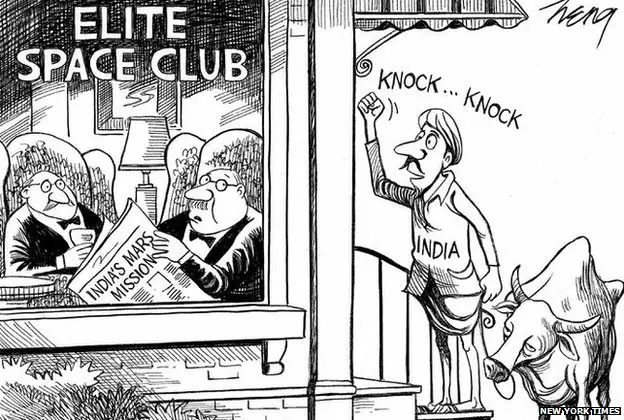
After India successful Mars Mission, Indian Prime Minister Narendra Modi had boasted that India spent less money to reach Mars than what Hollywood producers spent on making the movie “Gravity” (cost around $100 million to make).
No wonder, lot of Indians across the globe felt insulted on seeing the cartoon in The International New York Times, that supposedly mocked India.
Now, it would have been great if that cartoon was not published at all in the first place. But now that its published, is the depiction of India in that cartoon all wrong?
For those who have not seen the cartoon, here it is.

This cartoon experienced a backlash on the social media with readers complaining that the cartoon was racist in nature. There are several comments on social media where Indians have been critical of this cartoon.
Now I understand that…
- India, as a country, has made good progress in the last decade
- BMWs and Mercs are a common sight in most Indian cities, even in smaller cities
- After the Chinese, most number of Indian students go abroad for studies
- Decent sized flats in Mumbai cost around 2-3 crores (half a million dollars)
- Bollywood movies are easily making a couple of hundred crore rupees, and even production houses are ready to spend upwards of 100 crores on movies (Bang Bang was made for around 150 crores)
- Sussanne Khan allegedly has demanded 400 crores as alimony for divorcing Hrithik roshan
There are many more cases which might suggest that the cartoon is a wrong depiction of India & Indians.
But hold on!!!
Do the above examples really apply to the whole of India? Percentage wise, the number of people that fit in the above scenarios would still be a minority when you consider the entire Indian population.
So where’s the insulting or the racist part?
- Is it the cow in the picture? (You’ll find many on the roads of India’s financial capital city Mumbai)
- Is it the man with the turban, dhoti & the mustache? (almost 70 percent of India would wear that)
- The man looks too thin? (again, majority of Indians would look like that, and its better than being obese)
- Have you seen the Dabbawala’s in Mumbai?
- Wasn’t the Tata Nano supposed to fit in four to five adults?
- India’s new Poverty Line: Rs. 32 Per Day in Villages, Rs. 47 In Cities (no crores, lakhs, thousands or even hundreds here). Around 25% Indians don’t even make this much.
So is this really a case where Indians should feel insulted?
The original article does mention that “The intent of the cartoonist, was to highlight how space exploration is no longer the exclusive domain of rich, Western countries,”. Doesn’t it?
So where is the element of racism?
I’m sure everybody around the world acknowledges India’s feat. But the cartoon is definitely not as demeaning to Indians as its made out to be.
Nevertheless, The New York Times subsequently did publish an apology because of the backlash the cartoon generated. The apology letter posted on Facebook said:
“A large number of readers have complained about a recent editorial cartoon in The International New York Times, about India’s foray into space exploration. The intent of the cartoonist, Heng Kim Song, was to highlight how space exploration is no longer the exclusive domain of rich, Western countries. Mr Heng, who is based in Singapore, uses images and text – often in a provocative way – to make observations about international affairs. We apologise to readers who were offended by the choice of images in this cartoon. Mr Heng was in no way trying to impugn India, its government or its citizens. We appreciate that readers have shared their feedback, which we welcome. – Andrew Rosenthal, Editorial Page Editor.”
Andrew Rosenthal said that the cartoon was in no way meant to Andrew Rosenthal said that the cartoon was in no way meant to ‘impugn India, its government or its citizens’.The cartoon published by the New York Times showed a farmer, accompanied by a cow, knocking on the door of the Elite Space Club where two men sit reading a newspaper which has India’s space mission on the front page.
The cartoon was published after India succeeded in it’s much anticipated Mars mission, which was also the cheapest interplanetary space mission ever. India’s achievement was appreciated all over the world and it brought it at par with the United States, Russia and Europe who have previously sent missions to Mars.








